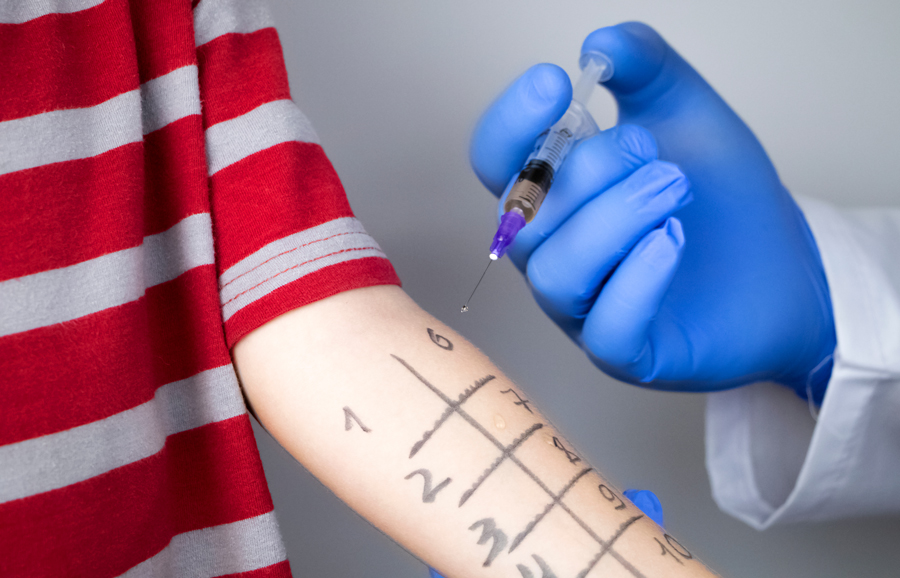Pediatric Allergist in Chicago
Allergies in Children

Common Allergy Symptoms, Diagnosis and Treatment
The most common types of allergies in children are seasonal allergies, skin allergies and food allergies. Knowing the signs and symptoms for each will help you be able to identify potential problems as early as possible and receive effective treatment.
Seasonal and Perennial (year round) Allergies
Based on symptoms, an allergist may recommend an allergy skin test to examine how your child’s body reacts to different allergens. Knowing what allergens trigger reactions is the most important part of effective treatment, as reducing or eliminating exposure to substances can greatly improve symptom relief. If this isn’t possible or effective, medications including decongestants, antihistamines, and nasal spray steroids may be prescribed. Your child may also be a candidate for allergen immunotherapy (allergy shots) to improve control, reduce or eliminate medications and prevent progression.
Skin Allergies
Have you ever noticed a rash on any part of your child’s body? Skin allergies can be uncomfortable and debilitating for children to deal with. This type of allergy is categorized in three different common forms:
Atopic Dermatitis (“Eczema”)
Contact Dermatitis (an allergen triggering rash)
Urticaria (“hives”) and angioedema (“swelling”)
Eczema, or “atopic dermatitis” and its close cousin contact dermatitis, is an inflammatory skin condition that develops because of a defective skin barrier, and causes itching, redness, and dry, scaly patches. The itch that it causes can be severe enough to disrupt sleep and cause children to scratch their skin, sometimes leading to infection. It is often inherited by parents with a history of other allergic diseases such as asthma or allergic rhinitis.

With correct diagnosis from an allergist, eczema can be managed with prescription medication. Mild cases may be treatable with moisturizers and ointments, while more severe cases may require prescription medication like topical steroids or antihistamine. Resistant cases may require biologic injections, such as Dupixent.
Urticaria and angioedema are red, raised, itchy skin lesions and swelling that have various triggers such as food allergies and other underlying inflammatory conditions. Those cases unresponsive to conventional treatments may be candidates for Xolair biologic injections to control symptoms without steroids.
Food Allergies
About 1 out of 13 children is are allergic to at least one food. The location and severity of symptoms can widely vary with each child, but they fall into four main food allergy categories:
- Skin – hives, eczema, swelling and itching of parts of the face and mouth
- Gastrointestinal – nausea and abdominal pain
- Respiratory Tract – runny and/or stuffy nose, shortness of breath
- Cardiovascualr system – lightheadedness and fainting
There are 8 common foods that contribute to food allergies in children:
- Milk
- Eggs
- Peanuts
- Tree nuts
- Fish
- Shellfish
- Soy
- Wheat
The difficult challenge of monitoring for food allergies is that most parents have no idea what their child is allergic to until they try a certain food for the first time. Reacting to a particular food also does not always mean there is an allergy – food intolerance can look like an allergic reaction. The difference is that an allergy involves the immune system and can progress and be serious, while intolerance is not a threat. To properly diagnose your child’s food allergy, an allergist may prescribe a combination of skin testing, sometimes blood testing, or an elimination diet. The results from these tests will determine which food is the cause, and what treatment and medication to recommend.
Premier Allergy, Asthma & Sinus Care provides comprehensive evaluation, testing and treatment for a full range of allergy and immunology conditions in children. We take care to explore your child’s condition, your family history, lifestyle and environment you live in. We provide both patient and parent education to ensure you have proper resources to understand what substances, foods, and environments may trigger your child’s allergies.
If you suspect your child has an allergy, contact us today to schedule an appointment.




